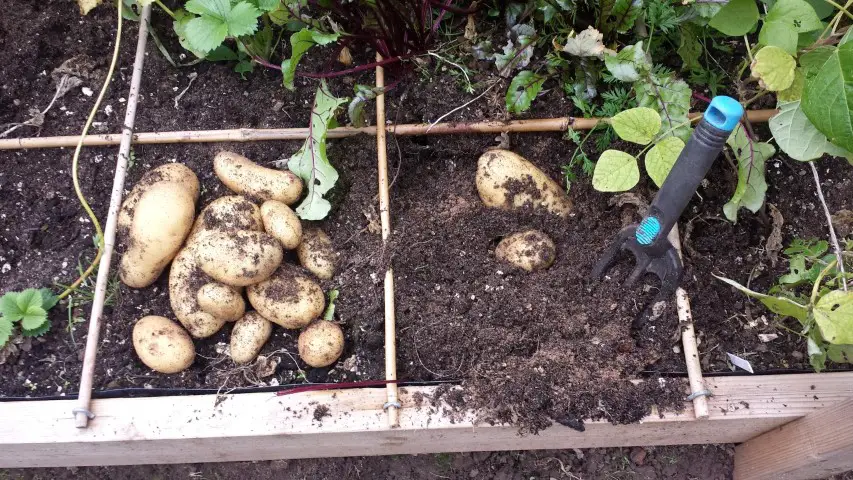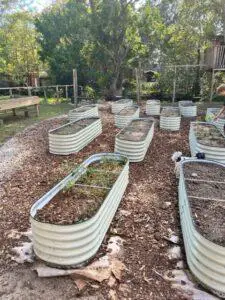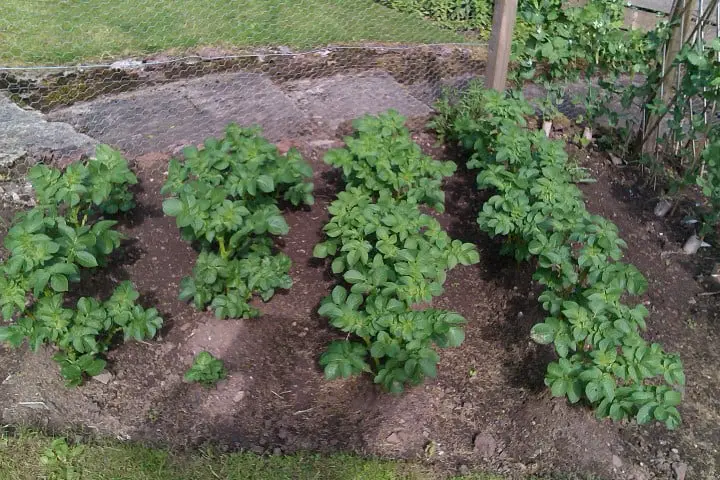
Raised beds are indeed an excellent choice for growing potatoes, the loose soil/compost mix creating a first-rate growing medium for all types of potatoes.
But exactly how deep does the bed have to be to accommodate the humble potato? The answer to this question depends on which method you are using, as there are in fact several ways to go about growing potatoes in raised garden beds.
The quick answer to the question though, is that the bed can be from 4 inches to 12 inches deep, and still produce an abundance of potatoes if you are using any of the methods listed below.
- Growing potatoes under straw. This method means that you can have a shallow 4-inch-deep raised bed. The potato is sunk only to its depth in the soil and then covered over with straw a few inches deep. The tubers grow between the soil and the straw covering and so creating a true no-dig garden as the straw is simply moved aside to harvest the potato crop when it is ready. More info on this method in this post.
- Shallow raised bed placed over soil. A raised bed does not have a base so that even if the sides of your bed is only 6 inches high, the depth of your soil can be whatever you have set it to. In the picture on this page you will see potatoes harvested from a 6 inch deep square foot garden placed atop poor quality subsoil. This still produced an excellent harvest of potatoes growing in the special SFG mix.
- Deep raised beds 12 inches and over can even be placed on a concrete surface and produce a great potato crop, as long as the soil mix is light and the tubers have room to expand (this includes all methods).
- Raised garden planters whether they be trough planters or planters on legs, have a solid base so they must also be over 12 inches deep if you want a decent potato harvest.
How to plant potatoes for a raised bed garden
Apart from planting the potatoes under straw as described earlier, a good way to plant potatoes to get the best yield from them is to start with a 12 inch deep frame filled to only about half way.
filled to only about half way.

Sink the potato into the soil then as it grows gradually add more soil around the shoots almost covering them over completely. Keep doing this until the bed is completely full with soil and let the potato grow to maturity.
The reasoning behind this, is the tubers will grow from the roots that spread out from the sides of the main shoot, thereby increasing your yield as you have lengthened the shoot and increased the number of potato-bearing roots.
This is a similar method to growing potatoes in a potato stack or bag. You can also choose to make your bed as deep as 24 inches using this method – but remember that is a lot of soil to dig out come harvest time, unless you build a planter with removable sides!
or bag. You can also choose to make your bed as deep as 24 inches using this method – but remember that is a lot of soil to dig out come harvest time, unless you build a planter with removable sides!
Hilling or Mounding potatoes

In a traditional ‘row’ garden you would sink your potatoes in a shallow trench and then create a mound over them. This is to increase the potato yield and also to help prevent the tubers going green if they are exposed to sunlight as they grow (green potatoes are poisonous owing to the build-up of chlorophyll and also solanine and not to be eaten).
In a raised garden bed or square foot model, there is little room for the mounding procedure, so this is usually abandoned and more care taken to avoid potato exposure – which is easier to accomplish in such limited space.
Spacing potatoes for planting
The space needed between potatoes for planting is something else that is different with raised beds. The potatoes only need 8-10 inches between them all around, instead of the usual 18-24 inches between tubers and 30-36 inches between rows in a traditional garden.
The reasoning behind giving the potatoes room to grow in a traditional garden is all about the yield, which is itself subject to the nutritional condition of the soil.
However with raised beds that are following correct procedure regarding the growing medium (soil), the nutritional value and condition of the soil far outweighs that of most garden ground.
This means that most if not all plants can be grown successfully even planted much closer together. The Square Foot Garden method is a classic example of this.
Preparing potatoes for planting

For preparing potatoes for planting in a raised bed, the same procedure is followed for preparation in a traditional row garden.
A couple of weeks before you plan to plant, place your seed potatoes in a tray exposed to the light at a temperature between 60-70F until they start to sprout. This is a practice called ‘chitting’.
in a tray exposed to the light at a temperature between 60-70F until they start to sprout. This is a practice called ‘chitting’.
After a few days when the sprouts are about 1 inch high, cut larger potatoes in half or even quarter – just be sure that there is at least 1 eye or sprout on each piece.
Dig a hole a few inches deep into the soft soil of your raised bed, place the potato inside, shoot pointing upwards, and cover over – being careful not to damage the young shoot.
If you are growing in a deep container and building up as the shoot grows just follow the procedure earlier in this article.
Corrugated Steel Raised Beds Here…
You might also like…Growing potatoes in straw bales

